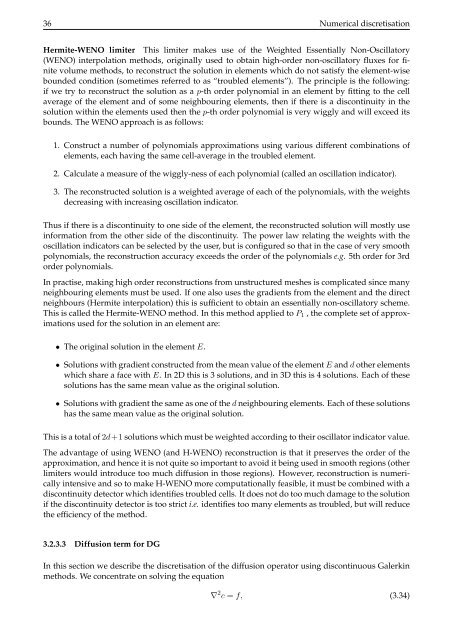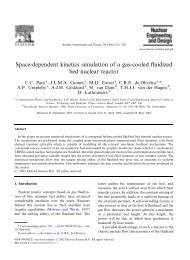Chapter 8 Configuring Fluidity - The Applied Modelling and ...
Chapter 8 Configuring Fluidity - The Applied Modelling and ...
Chapter 8 Configuring Fluidity - The Applied Modelling and ...
Create successful ePaper yourself
Turn your PDF publications into a flip-book with our unique Google optimized e-Paper software.
36 Numerical discretisation<br />
Hermite-WENO limiter This limiter makes use of the Weighted Essentially Non-Oscillatory<br />
(WENO) interpolation methods, originally used to obtain high-order non-oscillatory fluxes for finite<br />
volume methods, to reconstruct the solution in elements which do not satisfy the element-wise<br />
bounded condition (sometimes referred to as “troubled elements”). <strong>The</strong> principle is the following:<br />
if we try to reconstruct the solution as a p-th order polynomial in an element by fitting to the cell<br />
average of the element <strong>and</strong> of some neighbouring elements, then if there is a discontinuity in the<br />
solution within the elements used then the p-th order polynomial is very wiggly <strong>and</strong> will exceed its<br />
bounds. <strong>The</strong> WENO approach is as follows:<br />
1. Construct a number of polynomials approximations using various different combinations of<br />
elements, each having the same cell-average in the troubled element.<br />
2. Calculate a measure of the wiggly-ness of each polynomial (called an oscillation indicator).<br />
3. <strong>The</strong> reconstructed solution is a weighted average of each of the polynomials, with the weights<br />
decreasing with increasing oscillation indicator.<br />
Thus if there is a discontinuity to one side of the element, the reconstructed solution will mostly use<br />
information from the other side of the discontinuity. <strong>The</strong> power law relating the weights with the<br />
oscillation indicators can be selected by the user, but is configured so that in the case of very smooth<br />
polynomials, the reconstruction accuracy exceeds the order of the polynomials e.g. 5th order for 3rd<br />
order polynomials.<br />
In practise, making high order reconstructions from unstructured meshes is complicated since many<br />
neighbouring elements must be used. If one also uses the gradients from the element <strong>and</strong> the direct<br />
neighbours (Hermite interpolation) this is sufficient to obtain an essentially non-oscillatory scheme.<br />
This is called the Hermite-WENO method. In this method applied to P1 , the complete set of approximations<br />
used for the solution in an element are:<br />
• <strong>The</strong> original solution in the element E.<br />
• Solutions with gradient constructed from the mean value of the element E <strong>and</strong> d other elements<br />
which share a face with E. In 2D this is 3 solutions, <strong>and</strong> in 3D this is 4 solutions. Each of these<br />
solutions has the same mean value as the original solution.<br />
• Solutions with gradient the same as one of the d neighbouring elements. Each of these solutions<br />
has the same mean value as the original solution.<br />
This is a total of 2d+1 solutions which must be weighted according to their oscillator indicator value.<br />
<strong>The</strong> advantage of using WENO (<strong>and</strong> H-WENO) reconstruction is that it preserves the order of the<br />
approximation, <strong>and</strong> hence it is not quite so important to avoid it being used in smooth regions (other<br />
limiters would introduce too much diffusion in those regions). However, reconstruction is numerically<br />
intensive <strong>and</strong> so to make H-WENO more computationally feasible, it must be combined with a<br />
discontinuity detector which identifies troubled cells. It does not do too much damage to the solution<br />
if the discontinuity detector is too strict i.e. identifies too many elements as troubled, but will reduce<br />
the efficiency of the method.<br />
3.2.3.3 Diffusion term for DG<br />
In this section we describe the discretisation of the diffusion operator using discontinuous Galerkin<br />
methods. We concentrate on solving the equation<br />
∇ 2 c = f, (3.34)




